The “Bottomless” subwoofer
Designer: MattCero
Project Time: 1-8 hours
Project Complexity: Amateur
Project Cost: $100-$500
Concept
I don’t have a lot of money so I used an end table from work that was to be thrown away as a cabinet for this sub. Total volume was 7.2 cubic feet. Project came in at less than $400 and I’m very pleased, very pleased. Someone help me out though. I left this thing without a bottom so when it sits on the floor, it is sealed on the rug but how does this affect the performance acoustically? Would this be “coupled” to the floor producing a partial infinite baffle if that makes sense? Thanks for reading.
Driver Selection
Dayton Audio UM12-22 12″ Ultimax DVC Subwoofer 2 ohm Per Coil. http://www.parts-express.com/pe/showdetl.cfm?partnumber=295-512
Enclosure Design
The enclosure was already built as I scavenged an end table from my work that was to be thrown away. Total volume was 7.4 cubic feet. Decided to go with ported for obvious reasons.
Amplifier/Crossover Configuration
Bash 300W Digital Subwoofer Plate Amplifier
Enclosure Assembly
The enclosure was already built as I scavenged an end table from my work that was to be thrown away. Total volume was 7.4 cubic feet. Decided to go with ported for obvious reasons. I did make a 4″ port and used PVC from Home Depot along with a
Conclusion
Wow, this thing rocks not just the living room but the entire house. My house has wood floors and is on a quiet dead end street. I was truly concerned that my neighbors might “feel” it as well. I’ll ask them and update this if I can.
About The Designer
I’m a Purdue grad, Mech. Eng. and former Navy Pilot and currently am in the IT industry. I love delving into projects and not spending a ton of money. I buy speakers from Craig’s List, gut them and put in better components from PE. I moved into this house and out of an apartment where I could not use a subwoofer. So, it’s high time for this project.

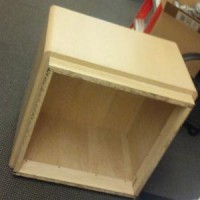
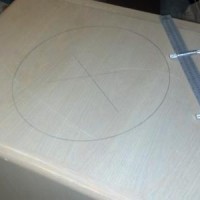
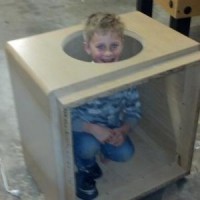

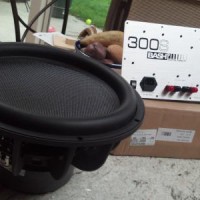
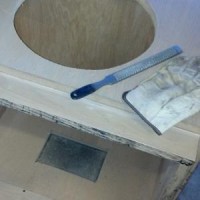
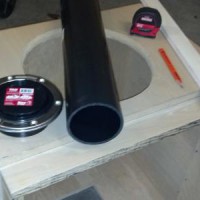
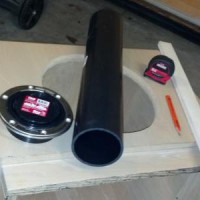
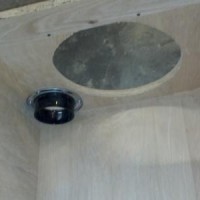
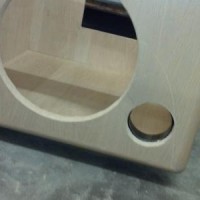
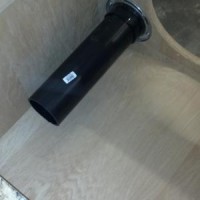
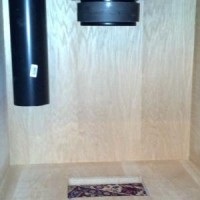
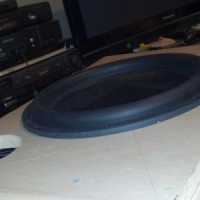
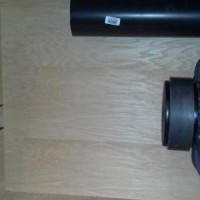
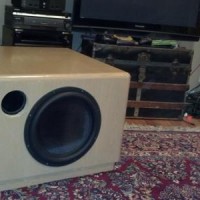
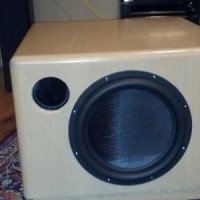
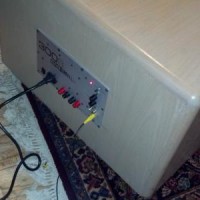
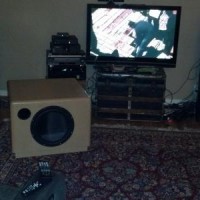
Dear Matt,
I see by your photos that you and your little helper like to get into your enclosure projects physically. I get it. I too like to delve into speaker enclosure projects, OK maybe not physically. I also see that this project was posted mid March of 2013. I am very surprised that no one has posted any comments or rendered any suggestions regarding your plea for help. By this time, I would guess you have made some alterations and added a bottom, but with no updates to your original offering to the Project Gallery, I will proceed.
First, I love the look of this end table. I also love to selvage items destined to a landfill. It is better still to reuse than to recycle. I am always looking for things that would make a good speaker enclosure. I believe you found an excellent one hear (<- spelling error and pun on purpose).
It may be possible the reason no one has responded is that the questions you ask are not easy ones and things get complicated very fast. As you know enclosures dramatically affect the acoustical performance of a driver, hence your question about the behavior of your bottomless one placed on a rug.
The two purposes of an enclosure is first to trap unwanted sound emanating from the back of the driver and second to add acoustic resistance so the driver can work more efficiently at low frequencies. The rug does not provide an effective seal to the floor. So the problem is first it leeks sound and second it cannot add acoustic resistance because it leeks. The latter is of the greatest concern.
Dayton Audio indeed makes some excellent drivers. I know because I enjoy them every day that I am at home. I always say, home is where your personal theater is. Although the driver you have selected for this enclosure has an EBP (Efficiency Bandwidth Product) of 35 and is more suitable for a closed box, it can perform very well in a vented enclosure. In fact, it would be my personal favorite for this driver.
One enclosure parameter is QL or the Q of a box caused by all leakage losses including wall vibration, leaky box, driver gasket seal, porous driver dust cap, and "lossy" driver surround. A result of a lossy box is increased QL (box leakage losses). Another result is Quicker roll-off of amplitude response with a corresponding higher F3 (the point where the frequency has dropped 3 dB). Lossy boxes diminish the effectiveness of a vent (Port).
Another result of a lossy box is increased apparent Vb (net internal box volume) which in turn increases the cone displacement. This is the most disturbing of all. It could result in the driver exceeding its Xmech (the maximum mechanical excursion of the driver) causing permanent damage to itself. This brings us to your question, “Would this producing a partial infinite baffle if that makes sense? The answer to this is yes and yes. You know more than you think or you would not ask. Again it is because the rug leeks.
The two most important details of a well-constructed enclosure are air tightness and rigidity. A vented enclosure will not be airtight because of the vent but all other aspects should be just as airtight as a closed design. An airtight box will have each joint glued and caulked. If the driver does not have a suitable seal, mount it with caulk. The same holds true for a plate amplifier.
You may want to glue in some 1×2” cleats along the inside edges of the end table to provide added strength and help prevent separation. The driver can produce tremendous transient pressure. The sides of the enclosure should not flex. Added braces can divide them into smaller sections and make them more rigid.
In regards to your question, “Would this be “coupled” to the floor?” the answer is no. Placing the cabinet on the rug would actually decouple the speaker enclosure from any solid support surface. It allows the enclosure to move slightly in response to driver movement. The result of that vibration is generally lesser performance adversely affecting its transient response and sound staging.
The rug was providing some damping to box resonances. To absorb box resonances without affecting the apparent volume of the box add damping material to one of each pair of parallel sides, most importantly the surfaces directly behind or near the driver. Excessive damping material can reduce vent output.
About the 4″ port tube, some readers may like to know that PVC is usually white and ABS, black and both used successfully for speakers. You mentioned twice that the Total volume of the end table was 7.4 cubic feet and once that it was 7.2. Measuring the internal dimensions and accounting for the volume of braces, driver and the plate amplifier come into play when calculating the length of the tube to use when tuning the enclosure to the desired frequency.
I assume you wired the DVC in series for 4 Ohms giving 600 watts. The Bash amplifier Specification is 300 watts RMS into 4-ohm load. If you are looking for an upgrade, the driver could handle more power when enclosed in a box that provides enough acoustic resistance (your end table with a bottom). If output in dB = Sensitivity in dB + 10*LOG of the Power in Watts, then 86.7 + (10*LOG 300) = 114.5 dB and 86.7 + (10*LOG 600) = 117.5 dB. However, my threshold of pain is probably around 105 dB anyway.
I hope this was helpful to you or any others who are still with us. At the least, it may help some understand why we work so hard at getting into our speaker enclosure projects.
Yours truly,
Phil Carter
Philip, thank you so very much for your thorough reply to my project. I have indeed “capped” the bottom with very sturdy ply wood and put cleats on the bottom. Thank you again Philip. Matt
Mornin’
I was looking for an infinite baffle example when I found this. I appreciate this project on many levels. As mentioned above, reducing waste is always good, but having fun at a hobby for cheap, is the best. I have had many projects where I take someone else’s old box and try different speakers, tuning, bracing… and try and learn from it. By leaving one side open, you have made it easy to play, change, test… I have heard that leaving the bottom out like you did, makes it act as a “variport” against the carpet, which uses foam rubber in the port to help tune it. I don’t have experience with these but I have left the bottom off of a few of my subwoofers while I evaluated, played and finished them. I did not notice any discernable difference. They were ported so the pressure was reduced none the less. I am wondering what you found when you sealed it. The one thing I can say without a doubt is that it greatly limits placement.
Peter